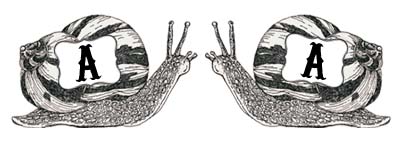The Nicene Creed as a Rationality Test
 Thu 2007-09-20
Thu 2007-09-20 PZ Myers at his most pugnacious:
The Nicene Creed is not a profession of the basic orthodoxy of the Christian faith. It's a rationality test.
If you believe one line of it, you've failed.
Ouff!
 Thu 2007-09-20
Thu 2007-09-20 PZ Myers at his most pugnacious:
The Nicene Creed is not a profession of the basic orthodoxy of the Christian faith. It's a rationality test.
If you believe one line of it, you've failed.
Ouff!
 Mon 2007-09-17
Mon 2007-09-17 I watched the first episode of the rerun of Ray Mears' Wild Food last night. In it Ray and Gordon Hillman visit Arnhemland to find out how Australian Aborigines went about searching for and preparing their food. Towards the end of the program their hostess is preparing a type of yam that needs soaking overnight to make it edible. She takes an empty snail shell, with a stick pokes a hole in its side, and then proceeds to use it to grate the yam into thin strips. Mears and and Hillman are quite impressed by the simplicity and effectiveness of this tool and they speculate that if such a shell turned up in an archaeological dig, it would be unlikely to be recognised as a tool.
 Sun 2007-09-16
Sun 2007-09-16 
The Proceedings of the Athanasius Kircher Society is a wonderful repository of the strange and bizarre. Browsing its pages is an ideal way to while away an spare hour or two. Today I came across there this 19th century proposal to use telepathy between snails as a means for communicating over long distances.
 Fri 2007-09-14
Fri 2007-09-14 Like many women, my wife Liz often worries about her weight. A few months ago she decided to make a determined effort to avoid high calorie foods and to get more exercise. She started weighing herself frequently and recording the results in her diary. However, it never seemed to occur to her to plot a graph of the results. Instead she seemed to judge her progress on whether the current measure was up or down on the previous one. She would come home and say "I've put on 2 pounds!" and be sad, or "I've lost 2 pounds!" and be happy.
I tried to explain to her about measurement error and that 2 pounds was probably not a significant difference, but she just wouldn't listen. On one occasion she became quite distressed because, apparently, she had suddenly "put on 10 pounds", only to find, to her great relief, that "it all came off again" the following day. I repeatedly told her that she should not be concentrating on the difference between the last two measurements but, instead, should be looking at the overall trend, and for that you need to plot a graph.
Eventually, I got her to sit down at the kitchen table with her diary and together we plotted the measurements out. The the result was the above graph (except that I have subtracted an arbitrary constant from all the values to disguise the true weights - we are only interested in the differences here). There are three things to notice about this graph:
Without plotting the graph, Liz would probably never have realised that her weight was slowly and steadily going down. Instead, she would have continued to be distracted by insignificant changes and the occasional faulty measurement. With the graph these can be clearly seen for what they are: irrelevant. Indeed, I would go as far as to say that any method of weight loss should include graph plotting if it is to be effective. Anyone attempting to lose weight must get a feel for how their weight changes over time and a graph is the best thing for giving that feel.
(Postscipt: The latest measurement, on September 15th, comes in at just under 0.5 stone on the above scale, so the downward trend is continuing. It looks as if Liz is on target for having lost 1.0 stone by November.)